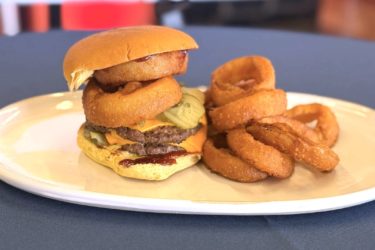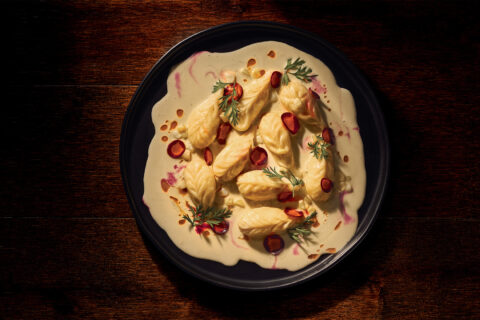The Local newsletter is your free, daily guide to life in Colorado. For locals, by locals.
What’s your go-to order at an Indian restaurant? If your first thought is chicken tikka masala, maybe with a side of naan, you’re in good company. But with the abundance of options for stellar Indian fare in Denver—many of which serve lesser-known specialties that more closely resemble the everyday cooking of Indian households—there is a call to explore.
Chef Charles Mani at Urban Village Grill, one of our 25 Best Restaurants last year, asserts that many diners are heeding this call. “I’m seeing that people are very much interested in trying every new item [we put out],” he says. Interest is just the first step, though. Knowing how to navigate the sometimes sprawling menus at Indian restaurants is another battle, and while Urban Village offers a tasting menu option to let diners sample a variety of new dishes, most restaurants don’t. That’s why we asked Mani to break down some less conventional Indian dishes that are easy—and dietary restriction-friendly—stepping stones from popular items like tikka masala, samosas, and naan. So if you love this, eat that.


Chicken Tikka Masala → Chicken Chettinadu
The origins of chicken tikka masala are still debated, but a common theory is that South Asian chefs who migrated to Great Britain in the 1970s invented the dish there, modeling it after butter chicken, a similarly dairy-forward dish developed and popularized in north India two decades prior.
Mani introduced the creamy, often mild curry onto his menu only a few months ago. “I’m not a fan of tikka masala because most of the people [who] are into that one… may not try all the other dishes,” he says. “It tastes too much of cream.”
While Urban Village’s version achieves that richness that many diners love, Mani recommends trying a curry like chicken chettinadu as an alternative. The dish, which originates from the southern Indian state of Tamil Nadu, has a tomato and onion base like tikka masala but completely eschews dairy. According to Mani, this lets the flavor of the hand-roasted spices shine through—a boon for dairy-free diners, to boot. It’s also an excellent option for those who crave a little more heat than tikka masala or butter chicken usually offers.
Samosas → Urban Cauliflower/Gobi Manchurian

Mani is not surprised that samosas are one of his most-ordered menu items. “[The] samosa is one of the most common street foods [in India],” he says. “[It’s] one of the most likable dishes for all kinds of people.” The chef often recommends tables to start off their meal with an order of them, but a different appetizer has actually turned out to be an even better seller: the Urban Cauliflower.
His spin on gobi Manchurian (which is served at Denver restaurants like Mehak India’s Aroma), the dish is emblematic of a hybrid Indo-Chinese cuisine that has centuries of history in India, beginning when Chinese laborers immigrated to Kolkata in east India in the late 1700s. The cuisine draws on ingredients from both countries and often employs Chinese cooking techniques like cornstarch-thickened sauces.
Enjoyers of General Tso’s chicken and similar Chinese dishes will thus be familiar with the sweet and sour flavor profile of the Urban Cauliflower. Mani coats individual florets in a gluten-free batter, fries them until crispy, then tosses them in a tangy tomato-chile glaze. According to the chef, the batter and the sauce combined make the cauliflower resemble chicken, making the vegetarian appetizer a solid option for even meat lovers.
Naan → Roti
Plenty of Indian menus carry both naan and roti among their selection of flatbreads, but the plethora of naan variations on those menus indicates that the former tends to be more popular. However, when it comes to how Indian families eat at home, according to Mani, they almost always go for the latter to scoop up curries for utensil-free eating.
The reason boils down to what’s feasible in a home kitchen. “Naan is made in a tandoori oven, which is 850 to 900 degrees, and then it takes like an hour [for the tandoor to heat up],” Mani says. While operating a tandoor and thus cooking authentic naan is impossible for most households, rotis are thinner, quicker to make (since they’re not yeast-leavened like naan) and can be cooked in regular pans. These qualities mean that roti (also sometimes called “chapati”) is generally considered the staple bread in India.
While customers should take the opportunity they have at restaurants to tear into pillowy, charred naan, roti is great for switching things up when you’re craving the familiar taste of your usual entrée order. It’s made with whole-wheat flour, which not only boosts its nutritive value but also lends it a nuttier taste that pairs well with a variety of other dishes. Also, roti is dairy-free (naan recipes sometimes include milk or yogurt), making it a safer option when ordering with lactose-intolerant guests. If you’re having a tough time deciding, Urban Village Grill lets you have the best of both worlds with its Village Basket, where you can choose a combination of three flatbreads for the table—the garlic and chive naan is another popular choice.
Also Try: Rasam
For most American diners, soup is probably not the first thing that comes to mind when it comes to Indian food. But Mani highly recommends trying rasam, a South Indian broth prepared with tamarind, turmeric, tomato, chile peppers, and various spices. While he doesn’t currently serve it on his menu (find it at restaurants like the Madras Cafe in Aurora), it is one of the healthiest foods he knows. “I’ve been in this country for 20 years,” Mani says. “I never went to the hospital. I always make [rasam] and drink.”
Read More: the Best Indian Food in Denver
18 of the Best Indian Restaurants on the Front Range
Battle of the Indian Buffets: Himchuli vs. Little India
How to Cook with Indian Spices, According to a Colorado Pro
6 Denver-Area Eateries Slinging Divine Indian-Inspired Drinks
Total Vegan Indian Restaurant Is A Haven for Plant Eaters
Why You Shouldn’t Skip Dessert at Spice Room in Highlands








